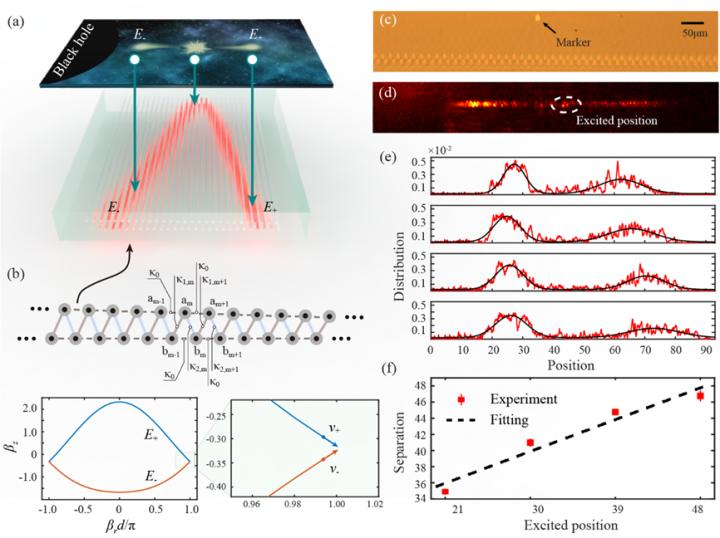Jul 17 2020
People’s unlimited yearning and imagination can always be aroused by the enormous scale of the universe. In this regard, a black hole is among the most fascinating celestial bodies in the universe, and yet, it has not been investigated and analyzed, to date.
 (a) The schematic of mapping the behavior of fermion pair into a photonic lattice. (b) The designed bi-layer waveguide lattice and the corresponding dispersion relation. (c) The cross-section profile of the fabricated lattices. (d) The imagined output probability distribution of single-photon wave packet splitting to two parts and moving in opposite direction. (e) The output probability distributions with different excited positions in the same lattice. (f) The separation distance increases with the excited position linearly. Image Credit: © Science China Press.
(a) The schematic of mapping the behavior of fermion pair into a photonic lattice. (b) The designed bi-layer waveguide lattice and the corresponding dispersion relation. (c) The cross-section profile of the fabricated lattices. (d) The imagined output probability distribution of single-photon wave packet splitting to two parts and moving in opposite direction. (e) The output probability distributions with different excited positions in the same lattice. (f) The separation distance increases with the excited position linearly. Image Credit: © Science China Press.
But restrictions in technology have prevented humans from exploring the depths of the universe, let alone come close to the purlieu of a black hole.
Luckily, on the basis of the equivalence between the electromagnetic parameters in electromagnetic materials and the metric of curved space-time in general relativity, physical researchers were able to design the technique of transformation optics to replicate the curved space-time of the gravitational field.
Researchers are now able to analyze and show how particles evolve in curved space-time at the experimental level. But to date, such simulations are restricted either in flat space or in the traditional regime, while quantum simulation associated with general relativity is hardly involved.
In the quantum field associated with the gravitational effect, several remarkable phenomena exist, for example, Hawking radiation.
Yao Wang and Xianmin Jin, both from Shanghai Jiao Tong University, and also Chong Sheng and Hui Liu from the Nanjing University have now made an interesting development in observing the behavior of particles close to the event horizon of a black hole.
Using the femtosecond laser direct-write technology, the coupling between waveguides and the waveguide on-site energy can be suitably managed. Taking a cue from the idea of transformation optics, the researchers were able to build a one-dimensional (1D) artificial black hole with the help of a single-layer non-uniform-coupling photonic waveguide lattice.
When compared to linear time evolution that occurs in the flat space, the dynamic behavior of single-photon wave packets close to the event horizon of a black hole speeds up exponentially. The exponential index of this dynamic behavior relies on the curvature of the black hole.
The researchers also developed the two-layer photonic waveguide lattice and visualized the generation, acceleration, and evolution of fermion pairs close to the event horizon of the black hole at the experimental level—that is, a single-photon packet with negative energy was captured, whereas a single-photon packet with positive energy effectively evaded the black hole.
The outcome, which digresses from the premonition that photons are invariably captured by black holes, is found to correspond well with Hawking radiation that fully evolves from quantum effects related to the gravitational effects.
Owing to fluctuations in vacuum, pairs of particles and antiparticles are produced close to the event horizon of the black hole. Positive-energy particles fall into the black hole, whereas negative-energy particles escape. As a result, the black hole loses its mass, and it would seem that the black hole has simply generated a particle.
In conclusion, the researchers believe that it is possible to build higher-dimensional curved space-time on the basis of the experimental platform. For instance, a 2D waveguide array with frequency or photon polarization can be employed to replicate 4D space-time, and a 2D waveguide array can be employed to replicate 3D space-time.
In addition, since the propagation direction plays the role of time in the experimental platform, researchers can also emulate the dynamics metric using this experimental platform, like FRW metric—a model elucidating cosmic expansion as time evolution, and a gravitational wave, which happens to be the ripple of space-time.
Journal Reference:
Wang, Y., et al. (2020) Quantum Simulation of Particle Pair Creation near the Event Horizon. National Science Review. doi.org/10.1093/nsr/nwaa111.